The Regional Situation Following the Restoration of Saudi-Iranian Relations
Policy Analysis | This analysis addresses the announcement of the restoration of Saudi-Iranian relations, sponsored by China, with an emphasis on the underlying motivations of both nations. Additionally, the analysis evaluates the impact of this announcement on the regional situation and its influence on a range of issues in the region.
by STRATEGIECS Team
- Release Date – Mar 19, 2023
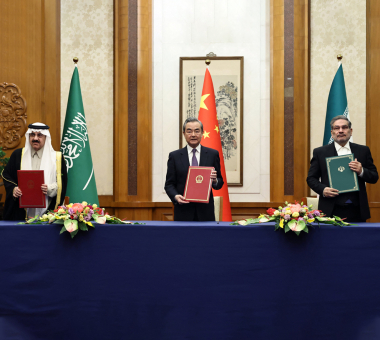
Through its mediation, China succeeded in restoring Saudi-Iranian relations, bringing seven years of severed relations between the two countries to an end. It came after several rounds of negotiations since 2019; first under the auspices of Iraq and then under the Sultanate of Oman. The meeting between the Saudi Arabian and Iranian foreign ministers on the sidelines of the 2022 Baghdad Conference in Jordan had also participated in restoring the relations of their countries.
During the past decade, Saudi-Iranian relations, with their divergence in positions and extreme contradiction on many regional files and issues, were of the most important files when discussing the regional situation of the Middle East, as Saudi Arabia and Iran had an impact on many of the region’s crises in Yemen, Syria, Lebanon, and Iraq. In addition, the Saudi Arabi and Iran dispute had its extensions in international contexts by influencing global events, as the two countries consolidated their relationship with international actors.
Restoring the relations between Saudi Arabia and Iran came along with the announcement of the intension to exchange diplomatic representation within two months, the affirmation of respect for the sovereignty of the two countries, non-interference in domestic affairs, and the activation of the Security Cooperation Agreement signed in 2001, as well as the Cooperation Agreement, signed in 1998 in the fields of economy, trade, investment, technology, science, culture, sports, and youth. This is besides the mutual statements that demonstrate a serious intention between the two countries to move forward for the success of restoring relations.
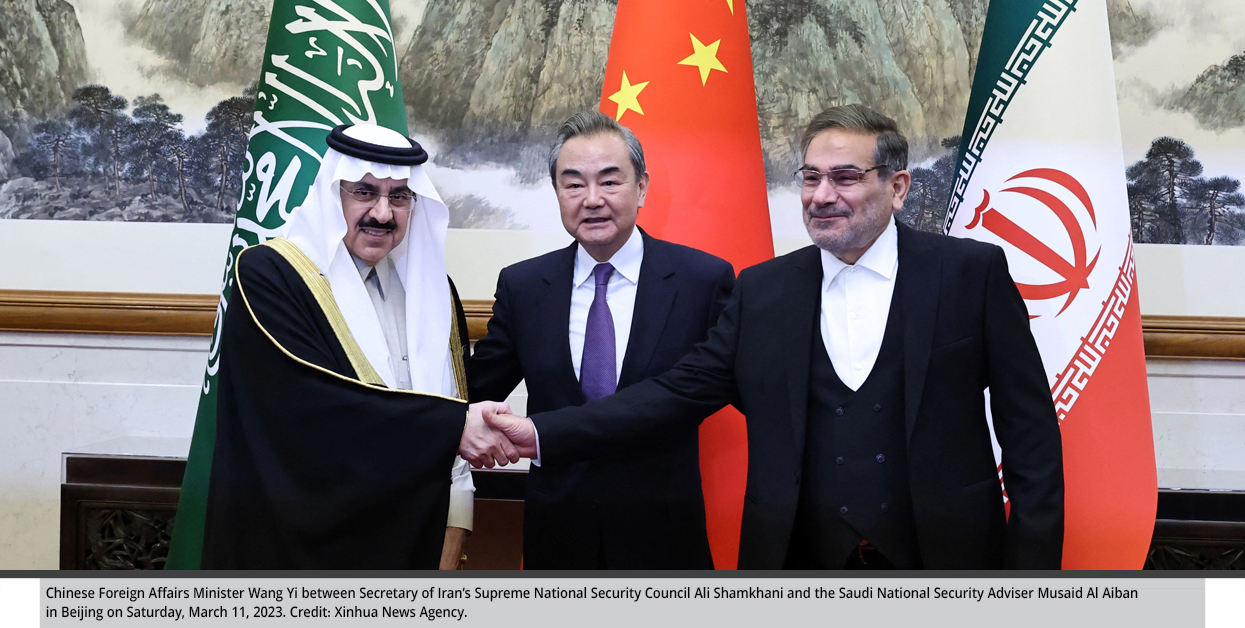
The success of agreeing to restore the relations between Saudi Arabia and Iran, despite the challenges such an agreement may face, will have an impact, in one way or another, on the regional situation as well as on the shape of relations between the countries of the Middle East and the status of the conflict arenas in the region. Such an agreement may also have an international dimension, specifically on the United States and China, the sponsor of relations. This impact is revealed by the motives of the two countries in announcing the resumption of relations at this time.
Timing Indications and the Dimensions of Restoring the Relations
While the international competition between the United States and China is intensifying, the timing of restoring the Saudi-Iranian relations has several indications with three dimensions, very close to the return of the Cold War. This time, however, it will be conducted through economic and diplomatic tools.
The United States is seeking to augment its control over the Indo-Pacific regions within a framework of alliances and partnerships, aiming to confront China’s growing expansion in Asia and the Pacific. The world witnessed the Quadrilateral Agreement (QUAD) that includes the United States, Japan, Australia, and India. Then came the AUKUS alliance between the United States, Britain and Australia. These alliances are an alternative to China in economic, information, and security affairs. They also provide a striking force equivalent to the Chinese influence across vast areas.
By heading towards hard and volatile regional environments such as the Middle East, China is seeking to break the encirclement the United States is trying to tighten around it. China concluded strategic partnerships with many countries in the region, especially Saudi Arabia and Iran, who have strategic interests with China. This was a point that enhanced announcing restoring the Saudi-Iranian relations.
In addition, the Chinese president’s visit to Saudi Arabia in December 2022 significantly strengthened Sino-Saudi strategic relations by concluding comprehensive partnership agreements, with many practical executive measures determined by timetables, foremost of which are memorandums of understanding aimed to align China’s Belt and Road Initiative with Saudi Vision 2030.
The same applies to Iran, which entered with China a 25-year Comprehensive Strategic Partnership signed in 2021, including the fields of transport, especially rail transport, energy, and infrastructure.
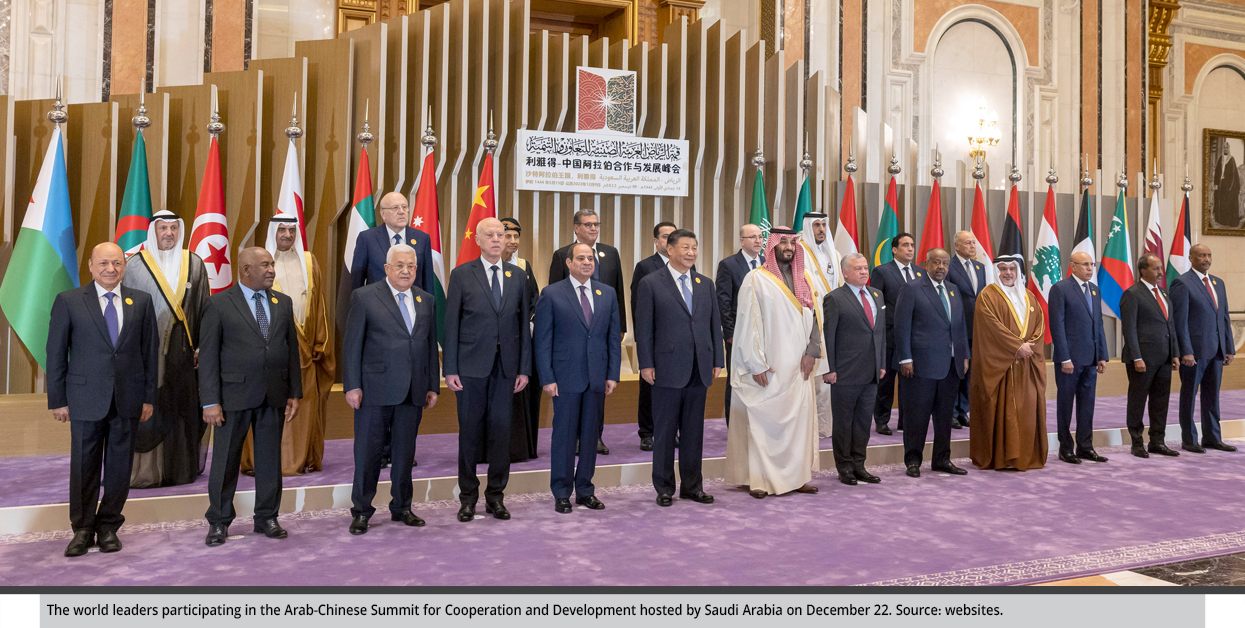
As for Saudi Arabia, the course of its relations with the United States is going through a major stage of reordering priorities, especially under the administration of President Joe Biden, who, along with some members of the U.S. Congress, announced a “reassessment” of Washington’s relations with Riyadh, following the October 2022 decision of OPEC+ to reduce petroleum production by about 2 million barrels. The decision came a few months after Biden visited Saudi Arabia in July earlier that year to hold talks on increasing oil production.
This tension in relations is not separate from shifts in Saudi foreign policy, which was moving for some time within a field of openness. Saudi-Türkish relations witnessed a remarkable rapprochement, translated through a Saudi contribution to relief and rescue operations during the devastating earthquake that struck southern Türkiye last February, and also with the announcement, by the Saudi Fund for Development of an agreement, to deposit $5 billion in the Türkish Central Bank. At the international level, Riyadh is seeking to diversify its strategic options in an international environment that seems to be moving towards multipolarity, which probably may not be realized during the next ten years, especially after the outbreak of the current Ukrainian crisis, and with the Sino-Russian partnership becoming stronger. China and Russia do not hide their desire to change the rules of the present international order.
The Saudi-Iranian rapprochement conforms with the transformations of Saudi foreign policy, and also with the changes in the international theater. It is also close to other conclusions Riyadh reached after its involvement in the region’s crises over the past decade. Such conclusions are that resolving the region’s conflicts, in favor of one party, is very difficult, if not impossible. On top of these crises comes the crisis in Yemen, where Saudi Arabia realized that its continuous involvement there is a drain on its financial capabilities, economic components, and military effort. Therefore, Saudi Arabia is moving towards resolving the Yemeni crisis, even in the pre-talks phase with Iran.
As for Iran (the other party of the event) it is experiencing an international isolation, amid many challenges and threats, in light of political and social chaos situation, which the Iran was witnessing since the outbreak of protests on September 8, 2022.
Previously, there were Iranian hopes that a nuclear agreement, with the Democratic Biden administration, was imminent, but the subsequent results of the Vienna negotiations showed the otherwise. In addition to the exacerbated economic pressures due to U.S. sanctions, and then the Covid-19 pandemic, there are foreign, domestic, and security pressures exerted by international and regional parties on Tehran in order to make it comply with demands of stopping its nuclear program, halt its ballistic missile development, and stop its regional behavior and hostile policies. With the popular protests, and the domestic, political and social turmoil, the Iranian regime is blamed for the deteriorating economic situation, due to the authorities’ preoccupation with crises abroad, and for channeling of state resources to its proxies in the region. Therefore, we can say that the space of the Iranian regime’s movement is at its narrowest, and that the options available for it are very limited.
The Regional Situation After Announcing Restoring the Saudi-Iranian Relations
The region’s crises and conflicts continue to prove the region’s need for a foreign party, in order to establish peace between the region’s countries, or to impose balances between its actors. While the announcement of restoring the Saudi-Iranian relations put China in a space that has been seen for decades as a role managed by the United States, it is too early to judge the outcome of that announcement. It is also too early to judge China’s ability as a mediator between two countries such as Saudi Arabia and Iran to maintain those relations. Accordingly, affecting the regional situation is related to many dimensions and factors. Herein are the three most important.
First, the dispute goes beyond diplomatic, technical, or even political approaches. It is a dispute between two projects with different ideological backgrounds, according to which each side adopts a regional view completely different from the other’s.
Iran’s expansionist efforts involve spreading its influence and supporting armed groups in various countries as a means to protect its national security from potential attacks by the United States, similar to what happened in Iraq in 2003. While this strategy is not primarily aimed at Riyadh, it has become part of a larger confrontation with Israel known as the “axis of resistance.” This strategy involves creating an armed perimeter around Israel’s borders with the Gaza Strip, Lebanon, and Quneitra, with supportive forces in Yemen and Iraq, to counterbalance Israel’s technological and air superiority.
Second, there are other influential actors in the regional scene, especially Türkiye and Israel. While the scope of restoring the Iranian relations seems to be minor for Türkiye, but it intersects with the regional situation that Israel is seeking to establish, in terms of Israel’s desire to expand both peace agreements and integration with the countries of the region, and in terms of Israel’s attempt to establish a regional alliance against Iran. Israeli opposition leader Yair Lapid described the peace agreements in the region as a collapse of the regional defense against Iran.
On the other hand, observers in Israel believe that Saudi Arabia’s continuation in its relations with Iran would not have been possible if countries of the region had confidence in Israel’s military capabilities to fatally strike Iran’s nuclear facilities or to enter into a wider war with Iran’s network of allies in the region. Therefore, Saudi Arabia chose not to bet on the capabilities of others, especially after it tested the American position during the attacks on Aramco petroleum facilities on September 14, 2019. Despite blaming Iran for such attacks, the administration of former U.S. President Donald Trump did not take a serious position that matches the danger.
Third, the U.S. point of view on restoring Saudi-Iranian relations is still unclear. On the one hand, America benefits from the fact that the agreement is commensurate with Washington’s desire to calm Middle East conflicts through diplomatic frameworks. Since its early days, the Biden administration encouraged adopting diplomatic frameworks in resolving disputes, and it authorized the countries of the region to follow procedures and steps aimed at reducing escalation.
Nonetheless, some American political and media elites view the agreement as one of the most important breakthroughs of Chinese diplomacy in the Middle East, as it came at a time when Washington is exerting pressure on its allies in the region to restrict Chinese access, especially in economic, political, and technological affairs. In this regard, the Saudi-Iranian agreement is interpreted as a sign of the U.S.’s decline in its ability to limit China’s growing influence in the Middle East.
In addition, the three parties to the agreement—China, Saudi Arabia, and Iran—are united in rejecting the American discourse based on reviving democratic values and human rights concepts, deeming it an American recipe for interference in the domestic affairs of countries. Taking into account the growing Sino-Russian alliance, the Iranian role in supporting Russian military operations in Ukraine, and Riyadh’s neutral position on the Ukrainian crisis, we find that the Saudi-Iranian agreement is strengthening the anti-American front, not only at the regional level but also internationally.
However, the impact of the agreement on the U.S. role in the Middle East remains limited since the Saudi-Iranian agreement does not enhance China’s role outside the diplomatic framework. Nor does it eliminate the major American role at the security and economic levels, especially in its relations with Saudi Arabia. After the announcement of restoring the Saudi-Iranian relations, the White House announced that Boeing concluded two deals with Saudi Arabia to manufacture up to 121 of (Dreamliner 787) aircraft, with an estimated value of $ 37 billion.
The United State’s ability to influence the course of Saudi-Iranian relations, as well as the Chinese mediation, through U.S. parallel or intersecting goals cannot be ignored. The U.S goals can be summarized as follows:
- In the context of the U.S. strategy of operating in a secure regional environment in Asia and the Pacific, the U.S. allowed China to play a greater role in the Middle East with a view to draining China in the region’s complex conflicts. It is true that the Chinese diplomats have achieved a great success, but they are facing many challenges in light of the ideological and doctrinal disputes between Saudi Arabia and Iran. For instance, the return of tensions between the two states is still very likely to happen. This could bring China to the center of conflicts, deepening China’s role in a complex and interconnected cycle of instability in the region.
- The U.S. administration has repeatedly confirmed its intention to complete the Arab-Israeli peace agreements. The United States is focused on Saudi Arabia as the next country to join this agreement. Israeli Prime Minister Benjamin Netanyahu expressed the same desire. Nevertheless, there is an awareness in Tel Aviv and Washington that Riyadh’s acceptance of normalization with Israel, after the agreement with Iran, will be with higher expectations by Riyadh regarding the gains and results of normalization with Israel, especially with the vanishment of the common threat factor that Iran represented to both parties, which constituted a factor in the Saudi-Israeli rapprochement.
- The U.S. administration is still committed to conclude the nuclear agreement with Iran, especially after the two countries have made great strides in the Vienna talks. China remains a strong guarantor of the agreement, as long as it remains the only way to break Tehran’s economic isolation. Reviving the nuclear deal would return Europe and the United States to the Iranian market, making Beijing lose its leverage on Tehran and, at the same time, renewing resources for Iran to overcome many of its problems, enabling it to restore momentum to its foreign operations, as happened after the previous agreement in 2015.
Regional Scene and the Tendency for De-escalation
In the context of the Saudi-Iranian talks, until the announcement of restoring the relations of the two countries, it is noted that they are limited to the security aspects of the Saudi Arabia and Iran. This is revealed by the security representation in the talks at the expense of diplomatic, political, or economic representation. The agreement to restore the relations—signed by Saudi National Security Advisor Musaed Al-Aiban and Iranian Secretary of the Supreme National Security Council Ali Shamkhani—indicates that the two countries are focused on neutralizing mutual threats rather than discussing regional crises.
One of the most important concerns for Saudi Arabia is ensuring that the attacks that targeted its territory would not occur again, whether from Yemen or Iraq. For Iran, the threats are related to its previous accusations of Riyadh influencing protests in Iran through its support for many popular Persian-language channels that broadcast from abroad inside Iran, in addition to ensuring Saudi Arabia’s neutrality towards any regional developments between Iran and Israel.
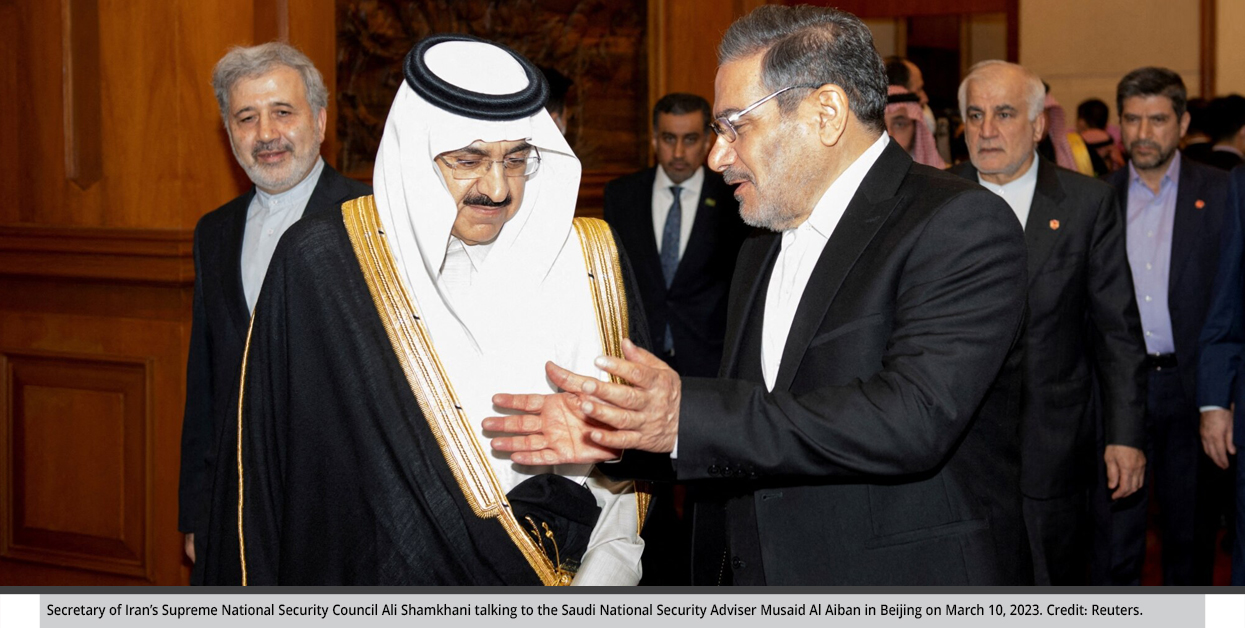
However, restoring the Saudi-Iranian relations may be reflected on the entire regional scene, without changing the present regional situation noted above. It is likely that the relations between the two countries and the scope of their interaction will be like a truce or disengagement. The impact of restoring the relations between Saudi Arabia and Iran is expected to affect the following arenas.
The Iraqi scene
Successive Iraqi governments were and still find themselves forced to achieve a balance between their relations with Saudi Arabia and Iran without tipping the balance of one over the other. Most Iraqi governments relied on different forms of diplomacy in Iraq’s relation with the two countries before taking today’s “economy for security” path of in which Arab countries, especially Saudi Arabia, engage in economic relations with Iraq in exchange for Baghdadhelp in making the government-armed factions peacefully co-exist with the countries of the region.
Iraq, which hosted several rounds of Saudi-Iranian dialogue, may benefit the most from restoring the relations between the two countries. The involvement of Saudi Arabia and Iran in direct economic relations would enhance Iraq’s ability to gain similar achievements at the regional level. This is, in fact, what Iraq is hoping for, and it is expressed in all of the Baghdad conferences. Iraq’s economic crisis, the deterioration of public services, and its energy and electricity crises require the widest amount of partnerships resolve and thereby restore the confidence of the Iraqi public in its political system.
The Yemeni scene
The Yemeni arena may witness the most prominent change since the Yemeni file and its complexities are a priority in Saudi calculations. It is certain that discussions with Tehran contributed in restoring the course of negotiations. Sources quoted by The Wall Street Journal indicate that Tehran pledged to stop supporting the Ansar Allah Houthi group, a step that demonstrates the intersection of Saudi-Iranian interests in Yemen, where the cost of Iran’s support for the Houthis is high.
Regarding the Yemeni negotiations that took place in Switzerland in early March 2023, private sources told STRATEGIECS that it is still too early to see the impact of restoring Saudi-Iranian relations on technical issues, prisoners, abductees, and how the political representation between the Yemeni parties would be.
But the aspect that can be built upon is the desire of the conflict parties to reach peaceful solutions. This was confirmed by Saudi Foreign Minister Prince Faisal bin Farhan at January’s World Economic Forum (Davos) when he declared that “ending the war in Yemen must be achieved through a consensual solution, which we are currently working on,” stressing that “the conflict is only going to end through a political settlement,” noting the need to find a way to restore the truce in Yemen and work to turn it into a permanent ceasefire.
In addition, the U.S. position on the Yemeni crisis has changed over the years from supporting one of the conflict parties to playing the role of mediator in the crisis. This change was solidified in February 2021 when President Joe Biden announced that America. would no longer provide support for military operations in Yemen, including arms deals, and appointed a special envoy, Tim Lenderking, to oversee U.S. involvement in Yemen
The Syrian scene
Restoring the relations may have less impact on the crises involving Syria and Lebanon. Although Riyadh is interested in resolving the Syrian crisis and supports the Jordanian initiative for a solution there, it is not clear that the Saudi-Iranian talks have similarly touched on the Syrian crisis as they did the Yemeni crisis. The Syrian crisis impact on the vital and strategic Saudi sphere is less than it is in the Yemeni one, yet the same controls imposed on the Iranian-backed armed groups in Syria are generalized to its counterparts in Iraq in terms of not compromising Saudi Arabia security or interests in the region.
In this context, it is important to realize that the chances of Syria to return to the Arab League and break the international isolation imposed on it require agreed-upon Arab and regional efforts. However, there are Russian and Arab efforts supporting Syria’s restoration to the Arab league after the devastating earthquakes that afflicted Syria. Damascus hosted some Arab foreign ministers; Assad visited Russia, where he met with Putin; and the Syrian president then visited the UAE and met with Emirati President Mohammed bin Zayed.
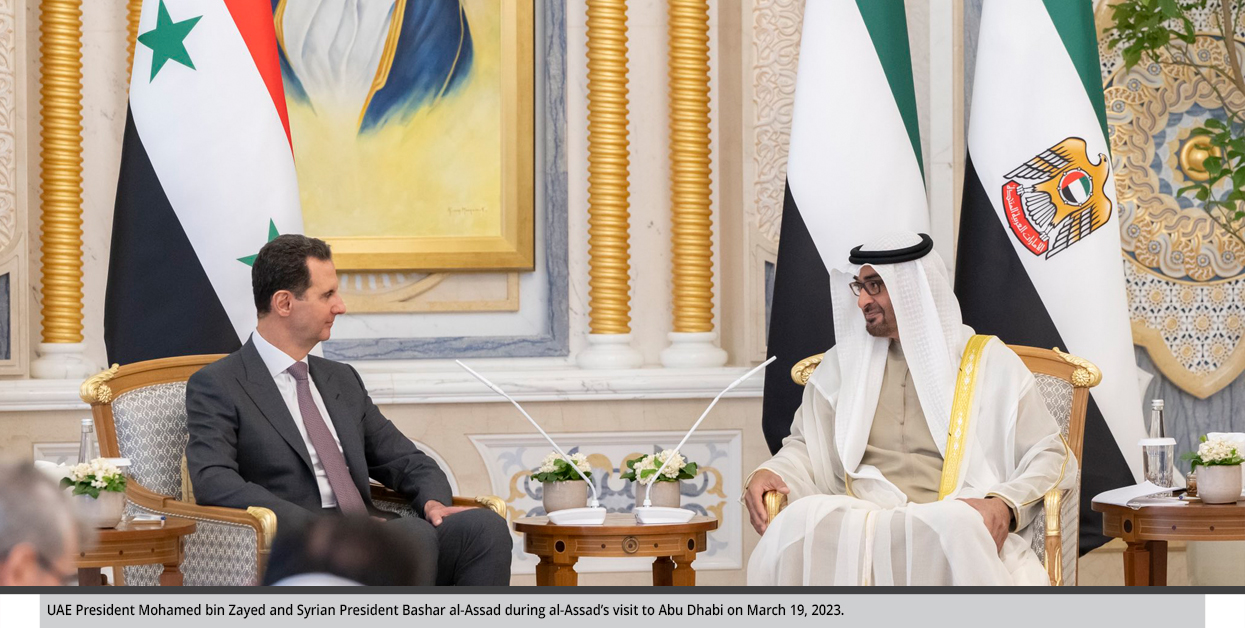
The Lebanese scene
Riyadh and Tehran are seeking to enhance their roles and influence, but Tehran and Hezbollah are facing a difficult economic situation that is shattering the country’s future. In addition, the position of the Lebanese president is still vacant as a result of the failure of the parties to the political process to reach a consensus. In this regard, Riyadh can help the Lebanese political parties in overcoming the issue of presidential elections, even if Saudi Arabia seems less interested in engaging in the crises of the surrounding countries or providing financial and economic assistance that their final destination is unknown. Hence, restoring the Saudi-Iranian relations may not be clearly reflected on the Syrian and Lebanese scenes.
The scene of Arab-Iranian rapprochement
The level of Arab countries’ desire for rapprochement with Tehran varies according to the different common files of such states. For example, Jordan and Egypt were more moderate in dealing with Tehran than Saudi Arabia. However, there are fewer chances that Jordan and Egypt will proceed in talks to normalize relations with Tehran. For Jordan, the spread of Iranian-backed armed groups on its northern border is one of its top priorities for national security, especially with the escalation of provocative operations practiced by these groups against Jordan. Therefore, expecting a similar Jordanian step towards Iran depends by the latter’s role in southern Syria. This is subject to a complex situation that makes it difficult to establish satisfactory arrangements for all parties, in addition to Jordan’s rejection of Iranian desires to open Amman for “religious tourism” for multiple considerations.
As for Egypt, there are several Iranian signs and messages indicating Iran’s desire to restore its relations with Cairo. Although there are no major disputes between the two countries, Egypt views the relations with Iran as part of the legacy of political Islam when the Muslim Brotherhood tried, during its accession to power in the country, to establish close ties with Iran when political Islam was a common aspect between the two countries at the time.
In the cases of Jordan and Egypt, however, both have relied on a policy of not closing all channels of communication with Iran. The Jordanian foreign policy has specifically adopted a de-escalation approach towards the region and its states despite the threat of the presence of Iranian-backed armed groups near Jordan’s northern border with Syria.
On March 19, Arab, Jordanian, and Iranian news outlets reported that His Majesty King Abdullah held talks with Iranian Foreign Minister Hossein Amir-Abdollahian about relations between the two countries during the second Baghdad conference. The Iranian news about an upcoming visit by His Majesty to Tehran can be described as exaggerated. An official Jordanian source corrected a report on the Ammon News website, adding that “[such a visit] is going to take place at the right time.” Hence, we believe that the “right time” will be governed by the political, security, and military conditions in southern Syria, and by the course of development of Iranian relations with the countries of the region.
As for the Arab Gulf states, sources quoted by The Wall Street Journal indicate that Beijing plans to hold a high-level Gulf-Iranian meeting this year, but that is another issue subject to contradicting views. For instance, while Abu Dhabi views the Iranian behavior as a threat to regional peace and security, it has maintained its economic relations with it. As for Manama, it previously faced a provocative speech from Tehran after the Bahraini government responded to the protests in 2011 that threatened the societal security in Bahrain. However, Bahrain may be more receptive to normalizing relations with Iran in the same key area as Saudi Arabia. Because Iran has shown interest in de-escalation with Saudi Arabia, this may also extend to Bahrain.
Finally, restoring the Saudi-Iranian relations is unlikely to bring about a significant change in the regional situation or the U.S. security and economic role in the Middle East. But at the same time, it represents a challenge for the Chinese mediator in ensuring an agreement without drowning in the finer details and complex challenges that characterize the region’s environment.
The normalization between the Saudi Arabia and Iran would relatively calm tensions in Iraq, and it may pave the way for a peaceful resolution of the Yemeni crisis, though it would have less impact on the Syrian and Lebanese scenes. Other Arab states, with limited exceptions, are unlikely to normalize their relations with Iran given that each country has its own situation and predetermined position towards Iran.
There is also a realization that it is too early to say with certainty what the outcome of the agreement between the two countries will be, despite the efforts that push for the success of relations. This is especially true since the messages exchanged between the two countries suggest there are upcoming steps at the economic and political levels, as indicated by the news that Saudi King Salman bin Abdulaziz invited Iranian President Ebrahim Raisi to visit Riyadh.

STRATEGIECS Team
Policy Analysis Team
 العربية
العربية